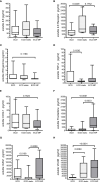An enhanced level of VCAM in transplant preservation fluid is an independent predictor of early kidney allograft dysfunction
- PMID: 36032101
- PMCID: PMC9403542
- DOI: 10.3389/fimmu.2022.966951
An enhanced level of VCAM in transplant preservation fluid is an independent predictor of early kidney allograft dysfunction
Abstract
Background: We aimed to evaluate whether donor-related inflammatory markers found in kidney transplant preservation fluid can associate with early development of kidney allograft dysfunction.
Methods: Our prospective study enrolled 74 consecutive donated organs who underwent kidney transplantation in our center between September 2020 and June 2021. Kidneys from 27 standard criteria donors were allocated to static cold storage and kidneys from 47 extended criteria donors to hypothermic machine perfusion. ELISA assessment of inflammatory biomarkers (IL-6, IL6-R, ICAM, VCAM, TNFα, IFN-g, CXCL1 and Fractalkine) was analyzed in view of a primary endpoint defined as the occurrence of delayed graft function or slow graft function during the first week following transplantation.
Results: Soluble VCAM levels measured in transplant conservation fluid were significantly associated with recipient serum creatinine on day 7. Multivariate stepwise logistic regression analysis identified VCAM as an independent non-invasive predictor of early graft dysfunction, both at 1 week (OR: 3.57, p = .04, 95% CI: 1.06-12.03) and 3 Months (OR: 4.039, p = .034, 95% CI: 1.11-14.73) after transplant surgery.
Conclusions: This prospective pilot study suggests that pre-transplant evaluation of VCAM levels could constitute a valuable indicator of transplant health and identify the VCAM-CD49d pathway as a target to limit donor-related vascular injury of marginal transplants.
Keywords: VCAM = vascular cell adhesion molecule; delayed graft function; extended criteria donor; kidney transplantation; machine perfusion.
Copyright © 2022 Baboudjian, Gondran-Tellier, Boissier, Ancel, Marjollet, Lyonnet, François, Sabatier, Lechevallier, Dutour and Paul.
Conflict of interest statement
All authors declare that the research was conducted in the absence of any commercial or financial relationships that could be construed as a potential conflict of interest.
Figures




Similar articles
-
The contribution of adhesion molecule expression in donor kidney biopsies to early allograft dysfunction.Transplantation. 2001 Jun 15;71(11):1666-70. doi: 10.1097/00007890-200106150-00028. Transplantation. 2001. PMID: 11435980
-
Hypothermic Machine Perfusion Results in a Marginal Kidney Transplant Programme.Eur Urol Focus. 2018 Mar;4(2):163-168. doi: 10.1016/j.euf.2018.05.011. Eur Urol Focus. 2018. PMID: 29929872
-
Hypothermic Oxygenated Machine Perfusion of Extended Criteria Kidney Allografts from Brain Dead Donors: Protocol for a Prospective Pilot Study.JMIR Res Protoc. 2019 Oct 14;8(10):e14622. doi: 10.2196/14622. JMIR Res Protoc. 2019. PMID: 31613224 Free PMC article.
-
Hypothermic Machine Perfusion Versus Static Cold Storage in Deceased Donor Kidney Transplantation: A Systematic Review and Meta-Analysis of Randomized Controlled Trials.Artif Organs. 2019 May;43(5):478-489. doi: 10.1111/aor.13364. Epub 2018 Nov 9. Artif Organs. 2019. PMID: 30282122
-
Machine Perfusion for Abdominal Organ Preservation: A Systematic Review of Kidney and Liver Human Grafts.J Clin Med. 2019 Aug 15;8(8):1221. doi: 10.3390/jcm8081221. J Clin Med. 2019. PMID: 31443179 Free PMC article. Review.
Cited by
-
Protein biomarkers in assessing kidney quality before transplantation‑current status and future perspectives (Review).Int J Mol Med. 2024 Dec;54(6):107. doi: 10.3892/ijmm.2024.5431. Epub 2024 Sep 27. Int J Mol Med. 2024. PMID: 39370783 Free PMC article. Review.
References
Publication types
MeSH terms
Substances
LinkOut - more resources
Full Text Sources
Research Materials

